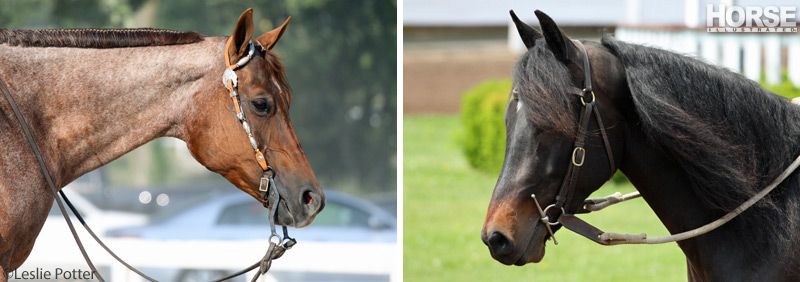
No piece of equipment is a substitute for training, rider experience, and time, but the right bit in your horse’s mouth will make the journey smoother along the way. Confusion and discomfort create distress, negatively impacting your horse’s comfort and responsiveness. Head-tossing, tongue flipping over the bit, bracing, running through the bit, gaping mouth, and high-headedness are signs that your horse is stressed. Smooth effortless responses, a quiet mouth, and a steady head show that your horse feels confident and relaxed. Choosing features that enhance communication through comfort is a great starting point for improving your horse’s comfort and responsiveness.
Balance
Comfort
Whether a snaffle or a curb, you should ride with a smooth, contoured mouth made of palatable materials. A mouthpiece that is shaped to match the curves of your horse’s mouth gives your horse more room for his tongue and prevents him from feeling relentless pressure that over time he will learn to ignore. View the bit from above to see if it is either straight from end-to-end or bows forward slightly to enhance your horse’s comfort. Choose sweet iron and/or copper inlay to sweeten the taste of the bit and promote a moist mouth. Stainless steel tastes awful to your horse and is drying to his mouth, which creates friction over the tongue and bars. The thickness of the mouthpiece is important too. A thin or twisted bit can do damage to your horse’s tongue and bars. However, an overly thick mouthpiece fills your horse’s mouth with continuous pressure and limits tongue mobility. A bit with a 7/16th diameter is well-accepted and a comfortable choice for most horses.
Curb Bit Comfort
If your horse is in a curb bit, you need to take port height and width into consideration too. Remember that the mouthpiece rotates down against your horse’s tongue and bars when you take slack out of the reins. A high port will push up into your horse’s sensitive palate, and should only be used on a horse that needs little guidance by an experienced rider with gentle hands. A low or no port will distribute pressure over a wider area, but be confining to the tongue and prevent your horse from swallowing. This is especially uncomfortable for a thick-tongued horse and tends to cause resistance in the jaw and poll. Small rings and prongs create further discomfort for your horse. A jointed mouth offers some tongue relief, but can act like a port by forming a peak and pressing into the roof of your horse’s mouth. A smooth medium port with some width offers maximum tongue relief without affecting the palate, concentrates most of the pressure on the bars of the mouth, and is a great choice for most horses and riders.
Responsiveness
A single-jointed snaffle bit provides excellent lateral communication and tongue protection, concentrating pressure on the bars of the mouth when the horse’s head is vertical and encouraging flexion at the poll. A double-jointed mouthpiece beautifully conforms to the shape of the horse’s mouth, evenly distributes pressure, and offers clear lateral signals. However, it isn’t a good choice for a curb bit because the communication will be sloppy and there is little or no protection for the tongue unless it has a locking mechanism that limits how far it can collapse. Moveable snaffle cheek rings/dees and curb shanks clarify lateral signals you send to your horse. Choosing loose shanks on your curb will make the bit softer and prevent the cue-muddying (and uncomfortable) “bit tilt” that can happen when a curb has no moving parts.
When you experience a communication breakdown or wish to enhance your horse’s performance, a bit that helps your horse clearly and comfortably receive your signals is essential for getting the job done.
Liked this article? Here are others you’ll love:
HorseChannel’s Online Bit Guide
Bit Advice
A Bit of Advice from Gina Miles







Bits are always something that real confused me. Most people buy what they think is right, and what they can afford.
I am just using the D ring Snaffle right now.. (I ride western)
I use a colt correction on my horse with a medium port. We do western riding and she responds very well to it. I’ve been working on keeping gentle hands while using it and she doesn’t resist. I was always confused on what bit to use for her, but my trainer recommended it, so I thought I’d give it a try. I feel that any bit can become harsh if you use it the wrong way. I’ve heard the colt correction is a very inhumane bit, but we use it on many of our horses and they ride fine with it.
Good advice.
I find bit fitting fascinating but I know it’s confusing for many and the horse suffers if people are not informed. My suggestions would be to write more articles, with pictures, and a lot of testimonies from riders. What do they use, why, what were their challenges? How did they know the bit worked or didn’t work??? Learning from others on their successes and failures sometimes is more valuable than just reading a informational piece of the functions of a bit or two. That’s just a little “bit” of what I think. 🙂